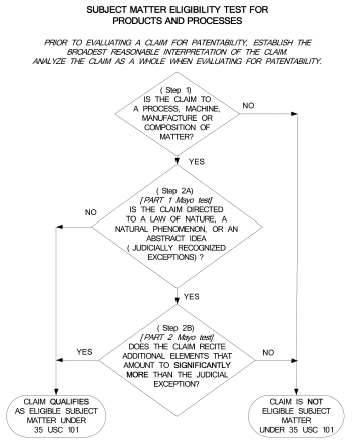The United States Patent and Trademark Office (USPTO) has issued updated guidance laying out the USPTO’s interpretation of the subject matter eligibility requirements of 35 U.S.C. 101. 2014 Interim Guidance on Patent Subject Matter Eligibility, 79 Fed. Reg. 74618 (Dec. 16, 2014). The new guidance supplements the USPTO’s June 2014 guidance issued following the Alice Corp. decision and supersedes its March 2014 guidance issued after the Myriad and Mayo decisions.
The new guidance includes a flow chart with the subject matter eligibility test.

Step 1 is to determine whether the claim is directed to one of the four statutory categories (a process, machine, manufacture, or composition of matter). If it is, Step 2A is to determine whether the claim is directed to any judicially recognized exceptions (a law of nature, a natural phenomenon, or an abstract idea). To determine whether a nature-based product falls within a product of nature exception (a law of nature or a natural phenomenon), the guidance applies a “markedly different characteristics” analysis. This involves determining whether there are any “markedly different characteristics” between the “structure, function, and/or other properties” of what is claimed and what occurs in nature. With respect to the abstract idea exception, the guidance explains that “[a]bstract ideas have been identified by the courts by way of example.” The guidance includes a number of “illustrative and non-limiting examples” of an abstract idea, such as mitigating settlement risk.
If the claim is directed to an exception, then Step 2B is to determine whether the additional claim elements amount to “significantly more” than the judicial exception. The guidance discusses examples of limitations that may satisfy the “significantly more” requirement, such as improvements to another technology or technical field, and limitations that have been found not to satisfy the requirement, such as the equivalent of simply adding the words “apply it.” The guidance also notes that claims that fall under multiple exceptions in Step 2A must satisfy the “significantly more” requirement for each exception in Step 2B.
The new guidance also instructs examiners to use “Streamlined Eligibility Analysis” for “a claim that may or may not recite a judicial exception but, when viewed as a whole, clearly does not seek to tie up any judicial exception such that others cannot practice it.” Such claims do not need to proceed through the full eligibility analysis where their “eligibility will be self-evident.” For example, a product with a merely ancillary nature-based component, such as a chair with a wood trim, would not require a full analysis of the product of nature exception.
The new guidance differs from the previous guidance in several important respects. First, the analysis is based on whether a claim is “directed to” any judicial exceptions. The new guidance explains, “the application of the overall analysis is based on claims directed to judicial exceptions (defined as claims reciting the exception, i.e., set forth or described), rather than claims merely ‘involving’ an exception.” Second, the test for determining whether a claim is directed to a product of nature exception (Step 2A) is separated from the analysis of whether the claim includes “significantly more” than the exception (Step 2B). Thus, a claim to a nature-based product could potentially be found to be patent eligible based on a showing of “markedly different characteristics” in Step 2A without needing to conduct the “significantly more” inquiry in Step 2B. Third, the “markedly different” analysis includes the “structure, function, and/or other properties” of a product, whereas in the previous guidance only “structural differences” were sufficient to show a “marked difference.” These differences may help applicants applying for patents related to nature-based products establish that the claims meet the subject matter eligibility requirements.
The new guidance also includes sample analyses applying the subject matter eligibility flowchart to several Supreme Court decisions and summarizes court decisions relating to laws of nature, natural phenomena, and abstract ideas. In reviewing the Federal Circuit decisions since Alice Corp., the guidance notes that “the Supreme Court did not create a per se excluded category of subject matter, such as software or business methods, nor did it impose any special requirements for eligibility of software or business methods.” As a supplement to the guidance, the USPTO also released a set of explanatory examples relating to nature-based products and plans to issue example sets relating to the “significantly more” requirement in the near future.
The USPTO is seeking written comments on the new guidance, as well as additional suggestions for claim examples to use for examiner training. Written comments must be received on or before March 16, 2015. Additionally, the USPTO plans to hold a public forum in mid-January 2015 to discuss the guidance and next steps and to receive additional oral input. The date and location will be provided on the USPTO’s website.
